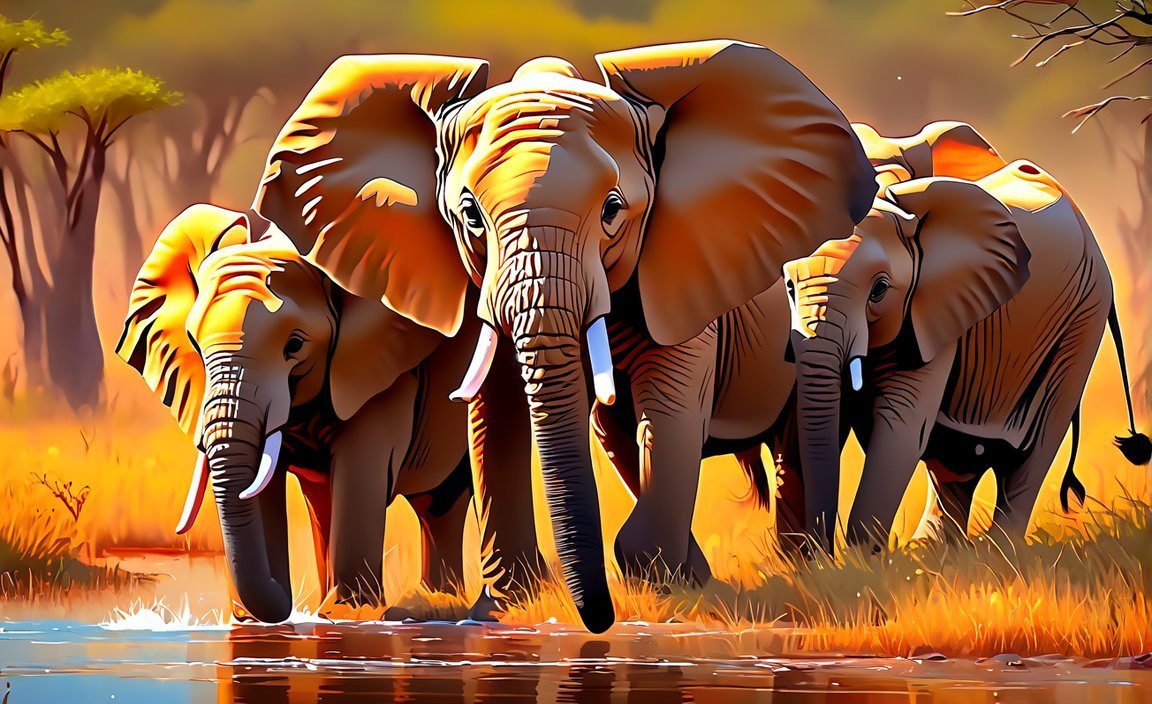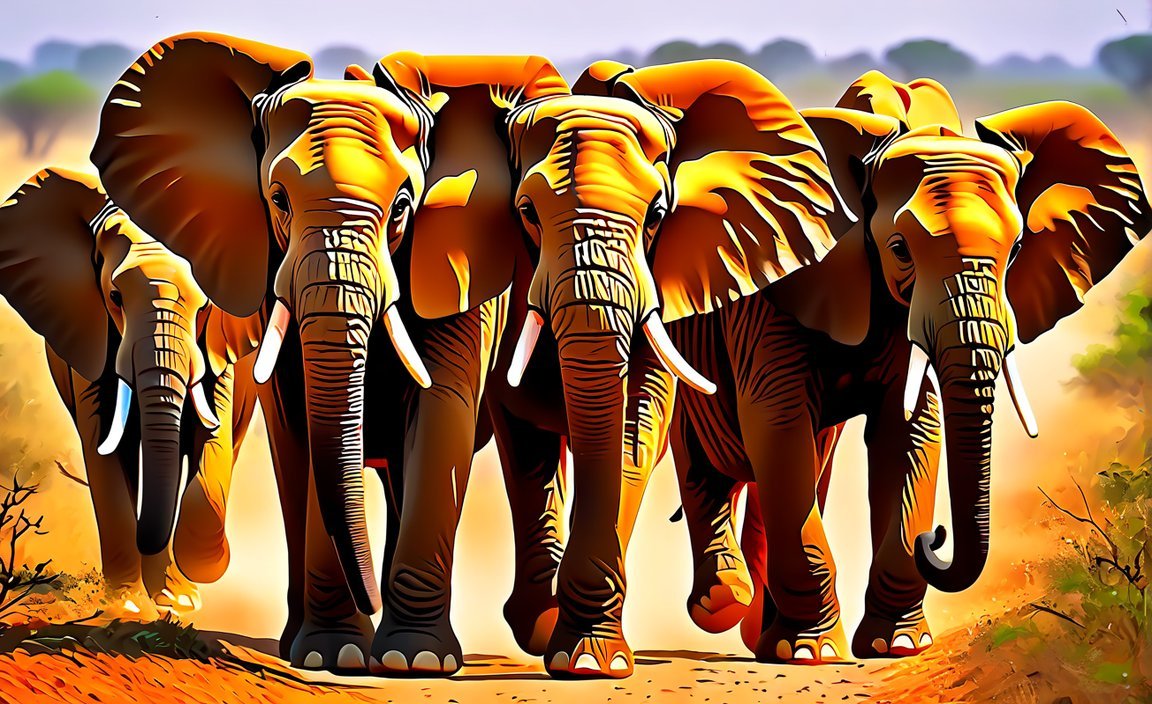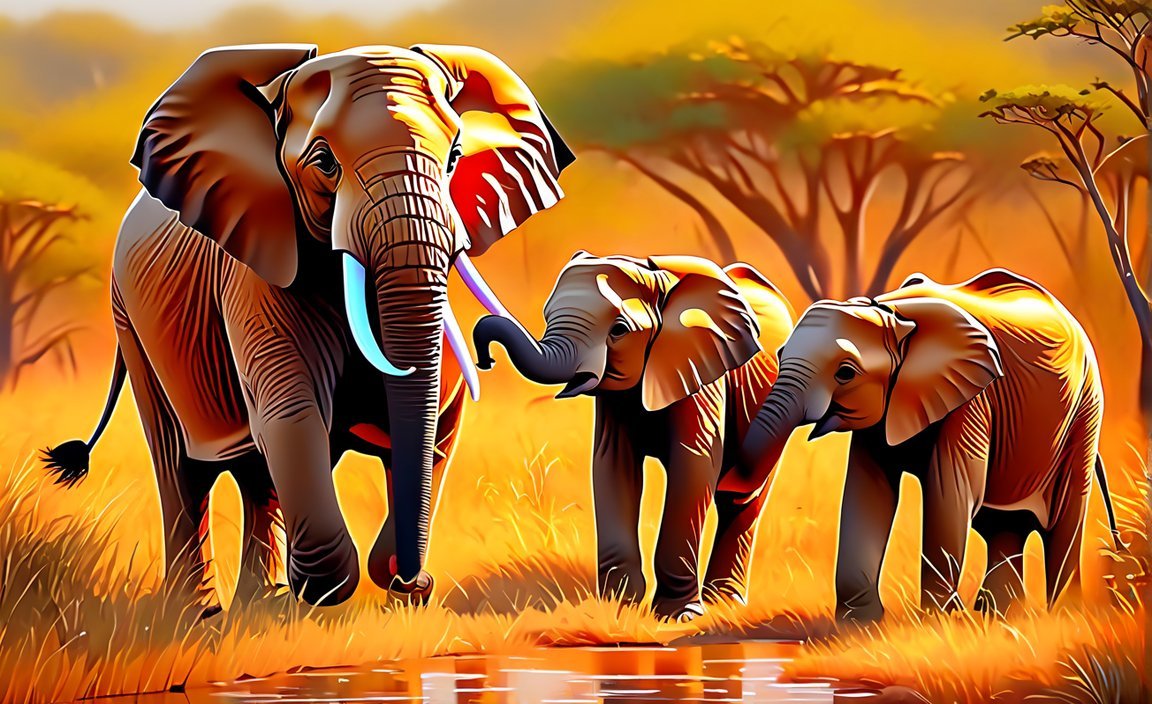African bush elephants, the world’s largest land animal, have long captivated the curiosity and wonder of wildlife enthusiasts. In this article, we delve into the intriguing world of these majestic creatures, uncovering fascinating facts that will leave readers in awe. From their impressive size to the surprising truth about their tusks, we explore the awe-inspiring abilities and unique characteristics that make African bush elephants truly extraordinary. Join us as we reveal the top five facts about these magnificent creatures.

Key Takeaways:
- African bush elephants can consume a massive amount of food and water daily, ranging from 220-660 pounds of food and up to 50 gallons of water.
- These majestic creatures can be found in various habitats such as savannas, deserts, and rainforests, showcasing their ability to adapt.
- Elephant herds are mainly led by females, highlighting the strong female dominance in their social structure.
- The head of an African bush elephant can weigh a quarter of its total body weight, showcasing its enormous size and strength.
- African elephants have an impressive lifespan, with the potential to live up to 70 years.
- The trunk of an elephant is a complex structure, consisting of over 40,000 muscles and tendons, enabling them to perform various tasks.
- Despite their immense size, these elephants possess the ability to snorkel without any external assistance.
- The tusks of African bush elephants are elongated incisor teeth, serving multiple purposes beyond just defense.
5 Fun Facts About African Bush Elephants
African bush elephants, also known as Loxodonta africana, are the largest land mammals on Earth and are known for their majestic presence. These gentle giants possess extraordinary characteristics that set them apart from other animals. Let’s dive into five captivating facts about African bush elephants that will leave you in awe of these remarkable creatures.
Fact 1: [A voracious appetite]
One of the most fascinating aspects of African bush elephants is their voracious appetite. These grand creatures can consume an astonishing 220-660 pounds (100 to 300 kg) of food per day! This amounts to approximately the same weight as a baby elephant. Imagine the sight of these herbivores browsing on a buffet of grasses, leaves, fruits, and bark. Truly a sight to behold!
Fact 2: [Master of diverse habitats]
African bush elephants are adaptable and can thrive in various habitats, showcasing their versatility. From the vast savannas dotted with acacia trees to the dense rainforests teeming with life, and even the arid deserts, these magnificent creatures call these environments home. Their adaptability allows them to navigate through different regions with ease, making them true masters of survival.
Fact 3: [Female-led elephant society]
In the elephant world, females reign supreme. African elephant herds are predominantly female-dominant, led by a matriarch who makes crucial decisions for the group. These intelligent and strong females guide their herd in search of food, water, and safety. Their social bonds are incredibly strong, with generations of elephants relying on the wisdom and experience of their matriarch.
Fact 4: [A head of mammoth proportions]
The sheer size of an African bush elephant’s head is awe-inspiring. The head of these majestic creatures can weigh up to a quarter of their total body weight. To put it into perspective, that is equivalent to the weight of four adult humans. This massive head houses their remarkable intelligence, tusks, and a powerful trunk capable of performing intricate tasks.
Fact 5: [Longevity of African giants]
African bush elephants are known for their longevity. These incredible creatures can live up to an impressive 70 years! Just like humans, elephants go through various life stages, including infancy, adolescence, adulthood, and old age. Their remarkably long lives provide them with ample time to form deep social bonds, witness the changing landscapes, and leave a lasting legacy for future generations.
African bush elephants truly are a marvel of nature. From their insatiable appetite and ability to thrive in diverse habitats to their female-led society, massive heads, and impressive lifespans, these gentle giants continue to fascinate and inspire awe. Next time you encounter them in documentaries or on safari, pause for a moment and appreciate the wonder that is the African bush elephant.
Aquatic animals offer fascinating insights into the mysterious underwater world. If you’re curious about these creatures, check out our article on 5 fun facts about aquatic animals and discover some amazing trivia!
8. A Baby Elephant Can Stand Within 20 Minutes of Birth
Did you know that a baby elephant is incredibly resilient right from the moment it enters the world? Within just 20 minutes of being born, a baby elephant can already stand on its own! Imagine witnessing this marvelous sight as the calf takes its first wobbly steps, guided by its mother’s gentle nudges and protective presence.
But standing is just the beginning for these young elephants. Within one hour of birth, they are able to walk, and after just two days, they can keep up with the rest of the herd. It’s truly remarkable how quickly they adapt to their new surroundings and become an integral part of the elephant community.
You might be wondering how such a small and delicate creature is able to achieve this impressive feat. Well, baby elephants are born with incredibly strong and sturdy legs, which allow them to support their own weight shortly after birth. This ability is crucial for their survival as it enables them to navigate their environment and stay close to their mothers, who protect and guide them in their early stages of life.
It’s not just about standing and walking, though. Baby elephants also have an exceptional desire to learn and explore. They use their trunks to investigate their surroundings, touching and grasping objects to familiarize themselves with the world around them. It’s a joy to watch them grow in confidence, developing their own unique personalities as they interact with fellow herd members and begin to understand the complexities of elephant society.
The bond between a mother elephant and her calf is undoubtedly one of nature’s most heartwarming sights. In their first hour of life, baby elephants quickly learn to suckle from their mothers, ensuring they receive the vital nourishment they need to thrive. The nurturing care provided by mothers and other female members of the herd plays a crucial role in the development and well-being of the calves, both physically and emotionally.
As baby elephants grow, their diet gradually expands from solely relying on their mother’s milk to incorporating solid foods. By the time they reach 7-8 months of age, they begin to munch on various vegetation, gaining the nutrients necessary for their rapid growth. This transition marks another significant milestone in their journey towards independence and self-sufficiency within the elephant family.
While it’s easy to get lost in the adorable antics and awe-inspiring abilities of baby elephants, it’s crucial to remember the broader context of these extraordinary creatures. African bush elephants, as the largest living land animals, have an immense impact on their ecosystems and play a vital role in maintaining the delicate balance of nature. By understanding and appreciating their fascinating lives, we can better appreciate the interconnectedness and wonders of the natural world.
Through their resilience, curiosity, and unwavering spirit, baby elephants embody the beauty and strength of these majestic creatures. Their ability to stand and walk within such a short period of time exemplifies their remarkable adaptability and innate survival skills. So next time you encounter a baby elephant, take a moment to marvel at its incredible journey and the wonders of nature.
Key Takeaways:
– Baby elephants can stand within 20 minutes of birth and walk within 1 hour, showcasing their remarkable resilience and adaptability.
– This quick development is possible due to their strong and sturdy legs, allowing them to support their own weight from an early age.
– The nurturing care provided by mothers and other female elephants is essential for the well-being and growth of the calves.
– As baby elephants grow, their diet transitions from solely relying on their mother’s milk to incorporating solid foods.
– Through their journey towards independence, baby elephants explore, interact, and learn about their environment, developing their own unique personalities along the way.
Sources:
– National Geographic: Baby Elephant (Citation: Baby Elephant. National Geographic. Accessed March 25, 2022.)
– African Wildlife Foundation: African Elephant (Citation: African Elephant. African Wildlife Foundation. Accessed March 25, 2022.)
5. They’ve got thick skin
African bush elephants are renowned for their incredible size and strength, but did you know that they also boast an impressive feature that sets them apart from other animals? Yes, you guessed it right – they have incredibly thick skin! Let’s delve into five fascinating facts about the thick skin of these majestic creatures.
Fact 1: Shielding and Cooling
An elephant’s skin is no ordinary casing – it measures a whopping 2.5cm thick! This thick layer not only acts as a shield against external threats but also plays a crucial role in regulating their body temperature. Elephants inhabit a diverse range of environments, from scorching savannas to humid rainforests, and their thick skin helps them adapt to these conditions.
The thick skin is capable of retaining up to 10 times more water than flat skin, allowing elephants to stay hydrated and cool themselves down in hot climates. This remarkable adaptation enables them to withstand the blistering African sun and maintain their body temperature within a tolerable range.
Fact 2: Dust and Mud Baths
Ever wondered how elephants keep their thick skin clean and protect themselves from sunburn? Well, these intelligent creatures have their own unique skincare routine – regular dust and mud baths! It might sound counterintuitive, but rolling around in the dirt or applying a layer of mud on their bodies serves multiple purposes.
First and foremost, the dusty or muddy layer acts as a protective barrier against harmful sun rays. Additionally, it helps in fending off pesky insects and parasites that might cause irritation to their sensitive skin. Moreover, the dust and mud provide some much-needed relief from the scorching heat by keeping their bodies cool, while also functioning as a natural moisturizer.
Fact 3: Largest Land Animal
While elephants’ thick skin is an impressive feature, it pales in comparison to their sheer size. The African bush elephant, the largest land animal on Earth, commands attention with its colossal presence. Towering over other animals, these gentle giants can reach up to an astounding 24 feet in length and 13 feet in height.
Fact 4: The Incredible Trunk
Elephants possess an extraordinary tool that aids in their various activities – their trunk. This specialized appendage is a marvel of adaptation, housing over 40,000 muscles and tendons. It allows elephants to perform intricate tasks such as reaching for food, drinking water, and even lifting heavy objects.
But here’s something truly astonishing: an elephant can lift its trunk into the air and breathe perfectly fine even when its entire body is submerged in water! This remarkable capability showcases the versatility and functionality of their trunk.
Fact 5: A Protective Shield
Elephants are susceptible to attacks from predators, especially when they are vulnerable, such as during infancy. Thankfully, their thick skin serves as a natural armor, providing protection against potential harm. It acts as a powerful barrier, making it incredibly difficult for predators to penetrate and inflict serious damage.
Moreover, the African bush elephant’s large ears play a vital role in maintaining their thick-skinned defense. By flapping their ears, they can dissipate body heat, contributing to their overall well-being in hot environments.
Key Takeaways:
- African bush elephants have incredibly thick skin that measures 2.5cm, serving as a shield against external threats and regulating their body temperature.
- Regular dust and mud baths help elephants keep their skin clean, protect them from sunburn, and provide relief from the heat.
- The African bush elephant is the largest land animal, reaching up to 24 feet in length and 13 feet in height.
- Their trunk, with over 40,000 muscles and tendons, is an extraordinary tool used for various tasks.
- Thick skin acts as a protective shield, making it difficult for predators to harm them.
Source: wwf.org.uk
Source: safaripartner.com

FAQ
Q1: Are African bush elephants the world’s largest land animal?
A1: Yes, African bush elephants are indeed the largest land animal on Earth. They can reach lengths of up to 24 feet and heights of up to 13 feet.
Q2: Are the tusks of African bush elephants actually teeth?
A2: Yes, that’s correct. The tusks of African bush elephants are elongated incisor teeth that first appear when they are 2 years old and continue to grow throughout their lifetime.
Q3: Can a baby elephant stand within 20 minutes of birth?
A3: Absolutely! Baby elephants have an amazing ability to stand within just 20 minutes of being born. They can even start walking within 1 hour and keep up with the herd after just two days.
Q4: Do African bush elephants have thick skin?
A4: Indeed, African bush elephants have thick skin that is about 2.5cm thick. This allows them to retain up to 10 times more water than flat skin, helping to cool them down. They also protect themselves from sunburn by taking regular dust and mud baths.
Q5: How diverse are the habitats of African bush elephants?
A5: African bush elephants are highly adaptable and can be found in diverse habitats such as savannas, deserts, and rainforests. They have successfully adapted to a wide range of environments.












